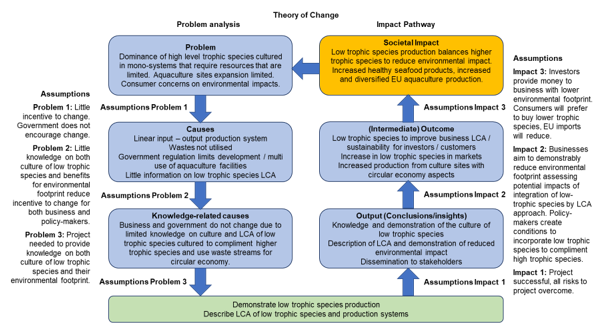BLUEBOOST – CULTURE OF A WIDE RANGE OF LOW-TROPHIC SPECIES TO BOOST SUSTAINABLE PRODUCTION OF BLUE FOOD AND REDUCE ENVIRONMENTAL FOOTPRINT
Introduction
The EU is the world’s largest importer of seafood (3,500 M€) with a self-sufficiency rate of only 27.8% in 2023 while EU seafood demand is increasing. The EU with its strategic guidelines for a more sustainable and competitive aquaculture sector, as well as strategies for the development of the blue bioeconomy, has clear ambitions to increase production from sustainable aquaculture. An integral part of this strategy is the enhancement of low trophic species production and the introduction of novel farming methods able to sustainably intensify aquaculture production, such as the development of Integrated Multi-Trophic Aquaculture (IMTA) systems. However, the uptake of IMTA and low trophic species culture by the industry has been disappointing due to significant challenges linked to systems complexity and the dominance of economic considerations in the decision-making process. However, l ow trophic species production can be integrated with higher trophic fed aquaculture species in a way that the wastes from the higher trophic species become resources for lower trophic levels using IMTA systems. Importantly, the strong but narrow and static economic focus on private costs and benefits that has so far limited IMTA uptake neglects environmental externalities and associated societal costs and benefits, such as utilisation of wastes at present causing eutrophication and stimulation of production circularity and pathways towards zero-carbon emissions. T he present state of the art acknowledges these possible environmental benefits of low trophic aquaculture and IMTA, but it does not quantify nor value those benefits, nor the societal gains from increased resilience. The challenge is to generate this data and show stakeholders the environmental and economic benefits of low trophic species culture and IMTA. BLUEBOOST aims to address these challenges:
a) Increase the aquaculture industry´s uptake of technologies for the culture of low trophic species together with established fed species to diversify and increase aquaculture production.
b) Describe and quantify the environmental and economic benefits of the culture of a wide range of low trophic species together with established fed species for stakeholders, in the aquaculture industry, policymakers and consumers.
Materials and Methods
BLUEBOOST partners have set up six IMTA case studies integrating the culture of low-trophic species (omnivorous fish, crayfish, molluscs, sea cucumber, sea urchin, seaweed , oysters and plants) with established aquaculture species (fish and shrimp) in Spain, Portugal, Italy, Poland and Brazil . In order to objectively evaluate, quantify, compare and adaptively reduce the environmental impacts of aquaculture with the implementation of IMTA production systems, Life Cycle Assessment (LCA) is used to assess the environmental impact (e.g. use of energy, land, water and greenhouse gas or nutrient emissions) of products and supply chains, a method underlying the EU Product Environmental Footprint (PEF) standard. The economic viability of these novel systems will also be assessed as profitability is a prerequisite for wider uptake and has been an obstacle for the development of IMTA systems to date. BLUEBOOST is an impact driven project that has applied the methodology of the Theory of Change to define pathways that show how project outputs can be transformed through communication to outcomes and societal change.
Results and Discussion
At the heart of the required changes is the industries’ ambition to sustainably intensify production activities and maximise economic return, together with society’s legitimate expectations to see the environmental footprint of goods and services being reduced. BLUEBOOST proposes to accelerate change in the aquaculture industry by addressing significant knowledge gaps that exist in the conceptual development, practical implementation and regulation of integrated aquaculture systems (Problem analysis) to provide outcomes and a clear pathway to change. BLUEBOOST outcomes predict the aquaculture industry will improve environmental credentials of businesses and products, consumers will demand low-carbon impact products and business investments and policymakers will provide a positive environment for the co-culture of low trophic and established species and deploy regulation to capture waste and reduce pollution. Therefore, Government policy and changing expectations of investors and consumers will drive aquaculture transition to carbon neutrality as shown in the impact pathway in the Theory of Change figure. This win-win scenario will deliver improved diversification of blue food / feed products and, at the same time, will increase production volumes to improve business economic returns combined with a reduced environmental footprint. Therefore, BLUEBOOST can deliver a concrete roadmap for the aquaculture industry to demonstrably reduce its environmental impact and increase sustainable blue food and feed production that can lead to societal transformation.
This societal transformation would generate changes such as: large increase in production of low tropic species, sustainable carbon neutral aquaculture, less pollution, less eutrophication, more wealth in rural coastal areas, improved costal environment, restored ecosystems, more species diversity and healthier diets.
Acknowledgements: BLUEBOOST (project nº SBEP2023-725) is cofunded by the EU through the Sustainable Blue Economy Partnership and national Government Research organisations , AEI Spain, FCT Portugal, NCBR Poland, MUR Italy, FORMAS Sweden, RCF Finland, and CONFAP Brazil.
